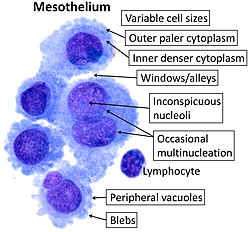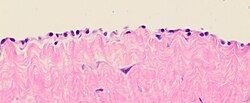Themesotheliumis amembranecomposed ofsimple squamousepithelial cellsofmesodermalorigin,[2]which forms the lining of severalbody cavities:thepleura(pleural cavityaround thelungs),peritoneum(abdominopelvic cavityincluding themesentery,omenta,falciform ligamentand theperimetrium) andpericardium(around theheart).
| Mesothelium | |
|---|---|
 | |
 | |
| Details | |
| Precursor | Somatopleuric mesenchyme |
| Identifiers | |
| Latin | mesothelium |
| TH | H2.00.02.0.02017, H3.04.08.0.00003 |
| FMA | 14074 |
| Anatomical terminology | |
Mesothelial tissue also surrounds the maletestis(as thetunica vaginalis) and occasionally thespermatic cord(in a patentprocessus vaginalis). Mesothelium thatcovers the internal organsis calledvisceralmesothelium, while one that covers the surrounding body walls is called theparietalmesothelium. The mesothelium that secretesserous fluidas a main function is also known as aserosa.
Origin
editMesothelium derives from theembryonicmesoderm cell layer, that lines thecoelom(body cavity) in the embryo. It develops into the layer of cells that covers and protects most of the internal organs of the body.
Structure
editThe mesothelium forms a monolayer of flattenedsquamous-likeepithelialcells resting on a thinbasement membranesupported bydense irregular connective tissue.Cuboidalmesothelial cells may be found at areas of injury, themilky spotsof theomentum,and theperitonealside of thediaphragmoverlaying thelymphaticlacunae.The luminal surface is covered withmicrovilli.The proteins and serosal fluid trapped by the microvilli provide a slippery surface for internal organs to slide past one another.
Function
editThe mesothelium is composed of an extensive monolayer of specialized cells (mesothelial cells) that line the body's serous cavities and internal organs. The main purpose of these cells is to produce a lubricating fluid that is released between layers,[4]providing a slippery, non-adhesive, and protective surface to facilitate intracoelomic movement.
The mesothelium is also implicated in the transport and movement of fluid and particulate matter across the serosal cavities,leukocytemigration in response to inflammatory mediators, synthesis of pro-inflammatorycytokines,growth factors,andextracellular matrixproteins to aid in serosal repair, and the release of factors to promote the disposition and clearance offibrin(such asplasminogen). Mesothelial cells are capable ofphagocytosisand areantigen-presenting cells.The secretion ofglycosaminoglycansand lubricants may protect the body against infection and tumor dissemination.
Role in disease
edit- Mesothelioma:(cancerof the mesothelium) is a disease in which cells of the mesothelium become abnormal and divide without control or order. They can invade and damage nearby tissues and organs. Cancer cells can also metastasize (spread) from their original site to other parts of the body. Most cases of mesothelioma begin in the pleura or peritoneum. More than 90% of mesothelioma cases are linked toasbestosexposure.
- Mesothelial hyperplasia
- Intra-abdominal adhesions: Normally, the mesothelium secretesplasminogen,which removesfibrindeposits. During surgical procedures, the mesothelium may be damaged. Its fibrinolytic capacity becomes insufficient and fibrin accumulates, causing fibrous adhesions between opposing surfaces. These adhesions cause intestinal obstruction and female infertility if it occurs in the abdomen, and may impair cardiac and lung function in the thorax.
- Ultrafiltration failure: The peritoneal mesothelium is implicated in the long-term development of ultrafiltration failure inperitoneal dialysispatients. The presence of supra-physiological glucose concentrations, acidity, and glucose degradation products in peritoneal dialysis fluids contribute to thefibrosisof the peritoneal mesothelium, either byepithelial–mesenchymal transitionor increased proliferation of existingfibroblasts.A fibrosed peritoneum results in the increased passage of solutes across the peritoneum and ultrafiltration failure.
See also
editReferences
edit- ^Image by Mikael Häggström, MD. Sources for mentioned features:
-"Mesothelial cytopathology".Libre Pathology.Retrieved2022-10-18.
-Shidham VB, Layfield LJ (2021)."Introduction to the second edition of 'Diagnostic Cytopathology of Serous Fluids' as CytoJournal Monograph (CMAS) in Open Access".CytoJournal.18:30.doi:10.25259/CMAS_02_01_2021.PMC8813611.PMID35126608. - ^Victor P. Eroschenko (2008).Di Fiore's atlas of histology with functional correlations.Lippincott Williams & Wilkins. pp. 31–.ISBN978-0-7817-7057-6.Retrieved28 May2011.
- ^Image by Mikael Häggström. MD.
Reference for findings and causes:"Reactive Mesothelial Cells".LabCE. - ^Leopold G. Koss; Myron R. Melamed (2006).Koss' diagnostic cytology and its histopathologic bases.Lippincott Williams & Wilkins. pp. 124–.ISBN978-0-7817-1928-5.Retrieved28 May2011.
External links
edit- Mesothelioma: Questions and Answers(National Cancer Institute).
- Histology at KUMCepithel-epith01"Mesothelium"
- Histology image: 00102loa– Histology Learning System at Boston University - "Tissues, Layers, and Organs: transverse section of rat gut"